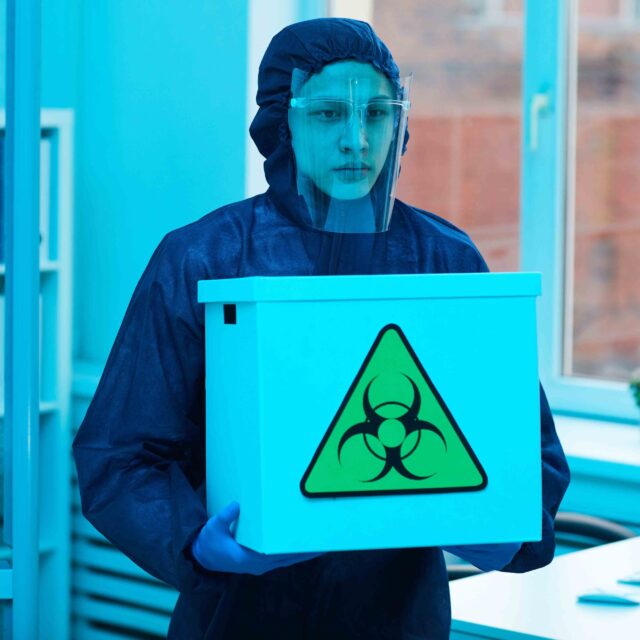One of the most important types of waste to manage correctly is hazardous waste, which may or may not be recyclable. However, what characterises this type of waste is that it presents a very high risk both to the environment and to the health of people and animals. For this reason, it is waste that must be handled in a special way.
In fact, each type of hazardous waste has an associated management protocol to ensure that it is handled correctly and does not become a danger to health or the environment. If you want to learn more about hazardous waste, its classification, some examples and its management, continue reading this article.
TABLE OF CONTENTS
Examples of hazardous waste
Hazardous waste management
How to distinguish hazardous packaging at home
The classification of hazardous waste is not uniform. Therefore, depending on the legislation, you may find one type of classification or another. However, in most cases, these classifications are equivalent to each other, as the waste remains the same regardless of where it is located. The following classification can therefore be regarded as a general classification of the most common hazardous wastes:
- Hazardous waste due to chemical reactivity: this is hazardous waste because it can corrode the surface with which it comes into contact or even become explosive. However, these wastes are not extremely hazardous in themselves, but could become so if they react with other substances, e.g. oxygen.
- Explosive hazardous waste: this is waste that, as its name suggests, can explode if not handled properly.
- Flammable hazardous waste: this is waste that is particularly sensitive to heat and can easily catch fire.
- Toxic hazardous waste: this is waste whose hazardousness derives from its toxicity to health and may be organic or inorganic.
- Radioactive hazardous waste: this is waste that is hazardous because it emits radiation.

EXAMPLES OF HAZARDOUS WASTE
Now that we have seen the main classifications of this particular type of waste, we will cite some examples in each of the corresponding categories:
- Corrosive hazardous waste: this waste is characterised by the fact that it is corrosive when it comes into contact with a surface. Many examples can be cited, especially with regard to acids, such as sulphuric acid;
- Hazardous waste due to chemical reactivity: these wastes are hazardous when they come into contact with other substances that cause them to react chemically. These include substances used in laboratories and many heavy metals such as mercury, cadmium and lead;
- Explosive hazardous waste: this is waste that can explode in contact with heat sources. The best known case is dynamite or gunpowder;
- Flammable hazardous wastes: these are substances that can burn easily, to the point of becoming explosive in certain specific situations. These are substances such as petroleum products or natural gas;
- Hazardous toxic waste: this is waste that is hazardous to health. In the case of inorganic waste, we are talking about substances such as arsenic or mercury, which are considered heavy metals;
- In the case of organic waste, the most obvious example is waste from health centres such as hospitals or laboratories;
- Radioactive hazardous waste: this is waste that emits radiation, such as uranium or plutonium. This is mainly waste generated in nuclear power plants.
HAZARDOUS WASTE MANAGEMENT
When handling hazardous waste, several factors must be taken into account. Firstly, it can only be handled by people trained to do so. This is the best way to avoid irresponsible handling, since those who handle hazardous waste have received the specific and necessary training to do so under the mandatory safety conditions.

Secondly, it should be remembered that the handling of hazardous waste must always be done with the necessary material and tools. In this sense, it is primarily clothing or equipment that prevents hazardous waste from posing a threat to the person handling it and the surrounding environment.
Finally, it must also be taken into account that each hazardous waste has a specific way of being managed, which is established by the management protocols corresponding to each case. As can be guessed, the management of radioactive waste will not be the same as that of toxic organic waste. Depending on the case, the protocol and safety measures required will be different and specific, and the management of such waste will have to be adapted to the protocols established in each case.
In many cases, they must be handed over to a licensed toxic waste manager to be properly managed from start to finish. Therefore, these wastes have additional requirements for storage, transport and treatment.
- Storage: waste must be stored safely and hygienically for a period of 6 months. In addition, hazardous waste must not be mixed with each other;
- Packaging and labelling: hazardous waste must have correct information on the packaging;
- Legality: producers of hazardous waste must keep records of their production and destination, have the appropriate administrative authorisation, report any incidents, make an annual declaration of production and use official documents;
- Prevention: a hazardous waste minimisation study must be prepared and submitted.
HOW TO DISTINGUISH HAZARDOUS PACKAGING AT HOME?
Normally, on the label or safety data sheet of the product or raw material we use, we find the corresponding pictograms that help us clarify any doubts about our waste. A discarded material or product must be handled as toxic or special waste when it has one of the following characteristics:

- Explosive
- Combustible
- Flammable
- Irritant
- Harmful
- Toxic
- Carcinogenic
- Infectious
- Mutagenic
- Ecotoxic
Some examples of hazardous waste are: most oils, solvents, absorbents, lead batteries, aerosols, Ni-Cd or mercury batteries, electrical appliances, laboratory reagents, paint residues and fluorescent lamps.
Therefore, if you are a producer of waste, do not forget that it is of paramount importance to know how to handle it correctly so that you do not endanger the lives of people living nearby or the environment.



